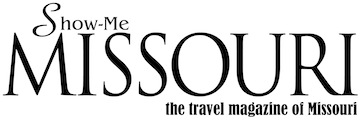Pedalers Bicycle Museum, Springfield
May 2025
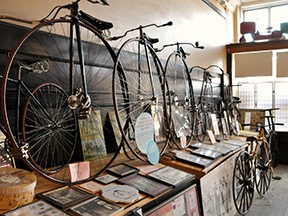
The non-profit museum, which opened in 2010, is housed in an 1887 brick building in Springfield’s Commercial Street historic district. Some of the bicycles in the collection are even older than the building, with one of the oldest being an 1817 strider bike, a “walking bicycle” used by surveyors in Germany.
The Missouri Bicycle and Pedestrian Federation has called it “the best and most complete bicycle museum in Missouri, and one of the best in the country and world.”
A popular item with visitors is the 1911 bicycle built by Orville and Wilbur Wright (of Wright Brothers of aviation fame) after they stopped building aircraft. Another is a replica of the 1890s-era bicycles used by Buffalo Soldiers in the 25th Infantry Regiment of the U.S. Army Bicycle Corps for a trip between Missoula, Montana, and St. Louis in 1897. There’s even a 23.5-foot-long custom-built bicycle for 12, and at the opposite extreme, a unicycle with one wheel for one person.
The high-wheel or big-wheel bicycles, popular between 1877 and 1892, are among his favorites. These bikes pair one big wheel with one small wheel. The League of American Bicyclists is a national group that encourages restoring and riding antique bicycles. As a member of the state chapter, Allen has pedaled thousands of miles on a high-wheel bicycle, including a 3,270-mile cross-country journey from San Francisco to Boston in 1991.
Bicycles with equal-sized wheels were introduced in the 1890s and are mostly what we ride today. In the early days, the high-wheel bikes were called “ordinaries” and the equal-sized-wheel bikes were called “safeties,” because they were less dangerous to get on and ride than the high ones.
With some 800 bicycles in his collection and many of them in storage, Allen rotates the exhibits to display different pieces. He can spin off a story for every item in the museum, so a tour can last as long as the visitor has interest.
Among the memorabilia, there are photographs, posters, magazines, books, tools, antique beer steins and even bicycle-themed wine bottles.
Pedal on over to the Pedalers Bicycle Museum for a fascinating tour of two-wheelers through history.
Pedalers Bicycle Museum is located at 328 East Commercial Street and is open 11 a.m.-4 p.m. Tuesday through Thursday or by appointment or chance. Visitors should call 417-576-1464 to arrange group tours. Admission is free, but donations are welcome.
Koshkonong Historical Museum, Koshkonong
February 2025
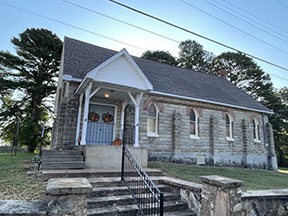
As a one-woman marketing machine, she is determined to boost attendance at the museum and bring Koshkonong new fame as the closest access to Grand Gulf State Park—if she could just convince the state or the county to pave that 3.2-mile-long gravel road that leads from the railroad track crossing in town to the entrance of the park.
Reed took on the challenge of refreshing the museum and boosting attendance first as a volunteer and now as part of her duties as city clerk. She recently moved her office to the museum, and she hopes to institute regular visiting hours soon. For now, folks can call for an appointment to tour the museum. Her dream is to make the museum the official welcome center for Oregon County, the place people will visit to begin their exploration of Grand Gulf and other county attractions.
At one point in its storied past, Koshkonong boasted a population of 3,000 and was considered as a potential site for the state capital. Today, the population is 212, but don’t be fooled by that small number. There is still plenty of local pride, which is on full display at the annual OCHS Heritage Day in October.
The museum is housed in the 1909 Christian Church building, which later served as a Masonic Lodge until the OCHS bought it in 1994. It now belongs to the City of Koshkonong, as does the nearby 1902 jail house—definitely worth a stop.
The building is packed with items from Kosh (as the locals call it) and Oregon County. One of the most intriguing is the story of the 9-foot 1-inch giant skeleton of a man that was discovered in a nearby cave, along with deteriorating, handmade giant-size furniture. There is a photocopy of a story from the St. Louis Globe-Democrat dated September 9, 1885, about the discovery. Standing beside the life-size cut-out of the giant makes a great photo op.
Other items in the museum include the original telephone switchboard and several antique telephones, a collection of hundreds of ceramic shoes, vintage clothing, the original church bell, school desks and memorabilia, an old-fashioned washing machine and much more. Kosh’s history as a major peach-producing area in the 1890s is documented.
The City of Koshkonong Historical Museum is at the corner of Luyster and School streets. Admission is free but donations are accepted. To schedule a visit, call 417-867-3260. On Facebook, look for The City of Koshkonong Historical Museum.
Maramec Museum, St. James
November 2024
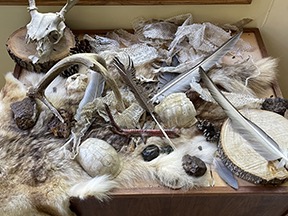
The number one attraction is Maramec Spring itself, which gushes some 96 million gallons of water a day. Feeding the fish in the spring branch is a fun activity, as is walking the paths through the trout hatchery area before heading into the park grounds to explore the remains of the iron ore furnace and related structures.
Picnic tables are scattered throughout the park, and there are several hiking trails. The Historic Drive takes you past scenic lookout points, the old Maramec Community Cemetery (1858-1882) and an open pit mine. There’s also a café, park store and campground.
For the purpose of this column, the focus is on the two museums in the park, the Maramec Museum and the Ozark Agriculture Museum, both of which are included in the park admission fee.
The Maramec Museum of Natural and Cultural History tells the story of the spring, from the Native Americans who lived alongside it through its heyday in the mid-1800s as an iron works to its current role as a 1,856-acre wildlife refuge and park. Large dioramas show how a village of 500 people grew up around the iron works and how the various structures functioned as part of a booming industry. Near the entrance, there’s a 21-foot-tall bluff with a small spring that flows into a 600-gallon aquarium. Displays show the recharge area for the spring and the water cycle. There are hands-on activities for children and a gift shop.
Fans of old-time agricultural equipment will want to visit the Ozark Agriculture Museum, a barn-like structure packed with all types of farm machinery and an assortment of farm equipment lined up outside. Be sure to note the in-ground rim shaper, which was used to make wagon wheels.
Old Iron Works Days, held annually on the second weekend in October, is a great time to visit the park. Live music, a fiddling contest, old-fashioned games and demonstrations of old-time skills and crafts are part of the festivities.
Maramec Spring Park is located on Missouri Highway 8 south of St. James. The park is owned and operated by The James Foundation, while the trout hatchery is operated by the Missouri Department of Conservation. Maramec Museum is open from 9 a.m. to 4 p.m. Wednesday through Sunday, April through October; 10 a.m. to 3 p.m. Saturday and Sunday, March and November. The Ozark Agriculture Museum is open by request. Admission to the park is $5 per car and includes the museums. For more information, call 573-265-7387 or visit MaramecSpringPark.com.
1944 WAR MUSEUM, Washington
August 2024
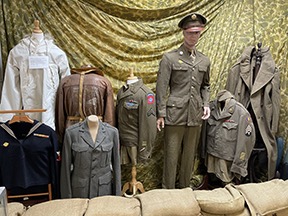
Pinter only started collecting World War II items about seven years ago, but his collection grew quickly and soon was overflowing the spare room in his home. The door of opportunity opened when Michelle Leesmann of USA Mortgage in Washington offered the spare suite next door to her High Street office to house the fledgling museum. As word spread, offers of help and donations of items began to pour in from family, friends and friends of friends.
What makes the collection so special is that so many items have a local or regional connection. Many were donated by the families of Franklin County soldiers who brought home souvenirs from their war experiences. Uniforms, guns, knives, a mess kit, medals, jewelry, newspapers, official documents, old photographs, foreign currency, telegrams—there is plenty to ponder when wandering through the exhibits. The collection is displayed according to three regions of the war effort: Europe, the Pacific and the United States.
Among the most moving artifacts are ones with personal touches, such as the trench art made by soldiers from both sides of the conflict, including drawings carved into canteens and other pieces of equipment. The wedding dress of a young soldier’s bride brings wartime romance to life. The most poignant to this visitor is the hand-pieced quilt with blocks for each soldier who enlisted from a small town in Oklahoma. There is an embroidered gold star on the squares of those who paid the ultimate price.
Some visitors might be surprised by the number of Nazi items on display, including a flag with a prominent swastika, but these were artifacts carried home as souvenirs by the victorious soldiers.
Volunteers to work at the museum are welcome, as are donations of wartime memorabilia.
The 1944 War Museum is located at 1380 High Street, Suite 6. Hours are limited and change frequently; check the museum’s Facebook page, The 1944 War Museum, each Sunday to see the coming week’s schedule as well as notice of special events. Admission is free, but contributions are appreciated. The museum is a 501(c)(3) non-profit organization and welcomes donations of World War II artifacts. For more information, email WashMo1944@gmail.com.
The Soda Museum, St. Charles
May 2024
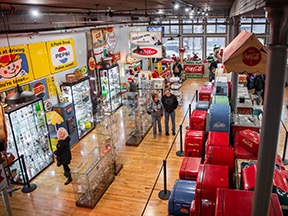
Smith’s love affair with all things soda related began when he bought a 1937 tray advertising Coca-Cola at the age of 10. The tray, which is in the museum, showed a woman in a yellow swimsuit running on a beach, holding a Coke in each hand.
Today the thousands of items in the museum include bottles, trays, vending machines, coolers, syrup cans, crates, toys, neon signs, games, wooden tubs and much more. The brands range from the familiar—Coca-Cola, Pepsi, Dr Pepper, 7-Up, Sprite, etc.—to the less familiar: Moxie, Devil Shake, Sunburst, Goldenmoon, Five-O, Bubble Up, Kickapoo Joy Juice, Brownie Root Beer, Squirt, Rio, White Cap and others.
“It has been my lifelong dream to share my passion and extensive collection of memorabilia in St. Charles,” says Smith, museum director and lifelong resident of St. Charles. “This museum is not just about the beverages; it’s about the stories, the innovations and the memories associated with sodas that have touched lives globally.”
The museum occupies a fully renovated building that dates to 1896. It was originally a hardware store. From 1939 to 1979, it was a J.C. Penney store, then from 1980 to 2018, it was home to Gene’s Shoes. The museum displays are on the main floor, mezzanine and top floor.
The basement houses an arcade with dozens of classic games collected by Smith’s father. There are pinball machines, bowling machines, air hockey, classic video games and more. Also in the basement, there’s a refreshment area where you can buy and taste almost 100 types of bottled soft drinks and enjoy a snack.
The museum is a fizzy walk down memory lane for soda lovers. History buffs will appreciate the effervescent tale of carbonated beverages from the 1880s onward. And arcade enthusiasts will find plenty of games to pass the time.
The Soda Museum and Main Street Arcade is located at 126 North Main Street in St. Charles. The museum is open from 10 a.m. to 6 p.m. Monday through Thursday; 10 a.m. to 8:30 p.m. Friday and Saturday; and noon to 5 p.m. Sunday. Admission is $10 for the museum; $15 for unlimited arcade game play; or $20 for a combo ticket. The Museum of Soda History is a 501(c)3 non-profit organization and accepts deductible donations of old soda items.
